Nazca Civilization › Inca Architecture » Ancient origins
Articles and Definitions › Contents
- Nazca Civilization › Ancient History
- Inca Architecture › Antique Origins
Ancient civilizations › Historical and archaeological sites
Nazca Civilization › Ancient History
Definition and Origins
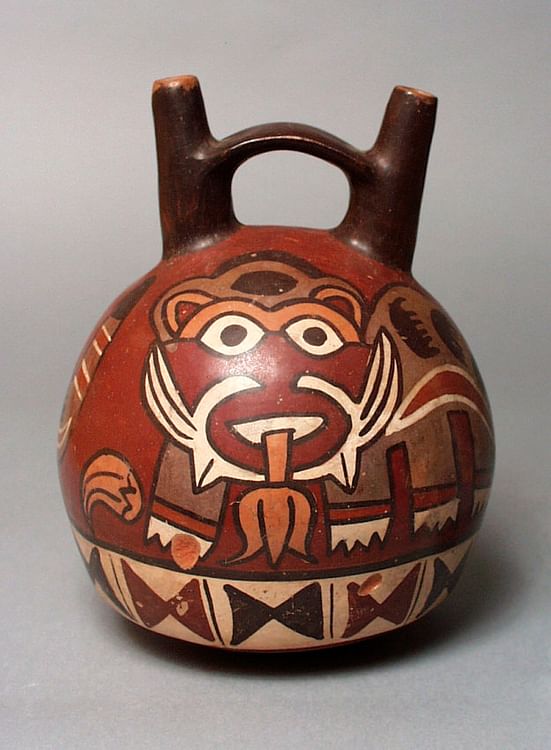
The Nazca civilization flourished on the southern coast of Peru between 200 BCE and 600 CE. They settled in the Nazca and other surrounding valleys with their principal religious and urban sites being Cahuachi and Ventilla, respectively. The culture is noted for its distinctive pottery and textiles, and perhaps above all, for the geoglyphs made on the desert floor commonly known as Nazca lines. These can be simple lines, cleared spaces, or animals and figures traced in outline, and, as they cover several kilometres, they are best appreciated from the air.
OVERVIEW
The Nazca were contemporary with, and then outlasted, the Paracas culture and many Paracas sites have been discovered beneath Nazca settlements. Politically, the Nazca civilization has been described as a collection of chiefdoms occasionally acting in unison for mutual interest rather than as a single unified state. Or as ME Moseley puts it, "individuality - with cultural coherence, but without large-scale or integrated power - were Nazca hallmarks". This interpretation is reinforced by the art and architecture of the Nazca which displays common themes across settlements but at the same time there is a general lack of uniform town planning or evidence of centralization. The maximum population of the Nazca has been estimated at 25,000 people, spread across small villages which were typically built on terraced hillsides near irrigated floodplains.
As they developed, the Nazca extended their influence into the Pisco Valley in the north and the Acari Valley in the south. In addition, as llamas, alpaca and vicuna do not survive in the coastal areas the use of their wool in Nazca textiles is evidence that trade was established with highland cultures. In addition, Nazca mummies have been discovered wearing headdresses made with the feathers of rainforest birds, once again, illustrating that goods were traded across great distances.
THE NAZCA HAVE LEFT A LEGACY OF DISTINCTIVE IMAGERY ON THEIR POTTERY, TEXTILES, AND ACROSS THE DESERT FLOOR OF PERU.
Graves, often placed up to 4.5 metres deep and accessed via a shaft, are the richest source of Nazca artefacts and reveal many aspects of the culture. Fine pottery and textiles were buried with the dead and with no particular distinction between male and female burials. The deceased is mummified, carefully wrapped in textiles and usually placed in a seated position, skulls sometimes display deliberate elongation, and we know the Nazca wore tattoos. Tombs, especially shaft ones lined with mud bricks, could be re-opened and more mummies added, perhaps indicating ancestor worship. Caches of trophy-heads often accompany the mummy, many showing signs of trephination which allowed several to be strung on a single cord as illustrated in pottery designs. Trophy-heads are also frequently incorporated into textile designs, especially in miniature and as border decoration. There were also burials of what appear to be sacrificial victims. These have the eyes blocked and excrement was placed in the mouth which was then pinned shut with cactus needles. Alternatively, the tongue was removed and kept in a cloth pouch.
Weakened by a generation-long drought in the 5th century CE, the Nazca were eventually conquered by the Wari - who assumed many of their artistic traits - and Nazca settlements, thereafter, never rose beyond provincial status.
VENTILLA
Ventilla was the Nazca urban capital and covered over 2 square kilometres (495 acres) and included ceremonial mounds, walled courts, and terraced housing. To fight the ever-present threat of drought the Nazcans built an extensive network of underground aqueducts, galleries, and cisterns in order to ensure a good water-supply during the dry season and minimize evaporation. These were reached by impressive descending spiral ramps and lined with river cobbles.
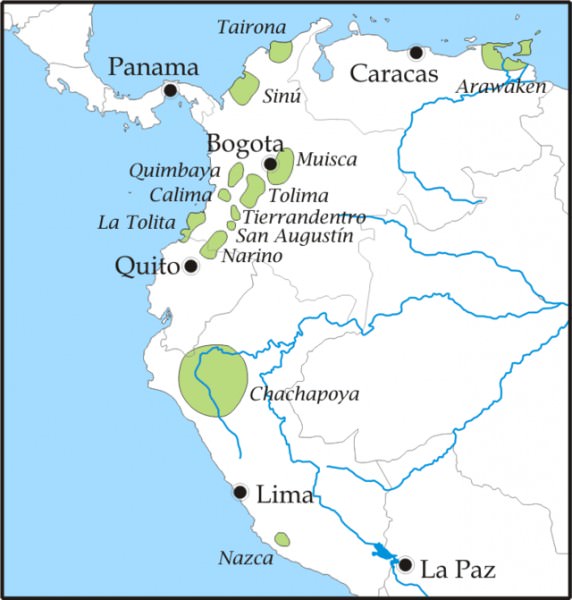
Nazca Civilization Map
CAHUACHI
Founded c. 100 BCE, Cahuachi, on the south bank of the Nazca River, 50 km inland, was a site of pilgrimage and the Nazca religious capital. It was probably first considered sacred because it was one of the few locations with a guaranteed year-round water supply. The lack of domestic architecture indicates it was not used as a place of habitation.
The sacred site covers 11.5 square kilometres (2,841 acres) and has around 40 large adobe mounds which take advantage of natural hills. The largest mound, known as the Great Temple, is over 20 metres high. All of the mounds have an adjoining plaza and are topped by adobe walls. The largest plaza measure 47 x 75 metres. A low wall, 40 cm high, surrounded the main sacred precinct. Posts and postholes across the site suggest canopies protected worshippers from the sun. Textile scenes also suggest that religious gatherings were connected to harvest festivals, and piles of rubbish consisting mostly of pottery shards at the site indicate ritual feasting. This rubbish was deliberately left so that it became a part of the mound.Consequently, the larger the mound, the more it had been used in rituals. Some mounds also contained burials and large pots containing fine textiles given as religious offerings.
More details of the religious ceremonies that may have been carried out at Cauachi are depicted in Nazca art, especially on pottery, and many are scenes involving shamans. These religious figures, in a drug-induced trance, appealed to nature spirits to guarantee favourable conditions for agricultural abundance. Music was an important part of these rites, as is evidenced by the abundance of ceramic drums and panpipes in the archaeological record. The principal Nazca god seems to have been the Oculate Being who is represented in art as a flying deity figure wearing strings of trophy-heads. He is frequently depicted in pottery and textile designs in a horizontal position with streamers flowing from his body. Large staring eyes and a snake-like tongue are other typical features.
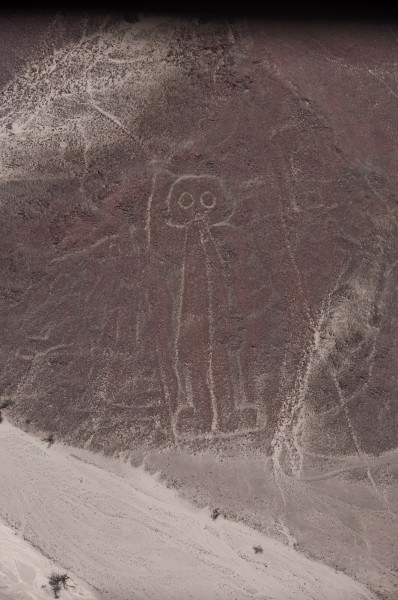
Nazca Line Human Figure
NAZCA LINES
The Nazca drew geoglyphs and lines across the surrounding deserts and hills which were either stylized drawings of animals, plants, and humans or simple lines which connected sacred sites or pointed to water sources. Their exact purpose is disputed, but the most widely held theory is that they were designed to be walked along as part of religious rites and processions.
The lines were made remarkably easily and quickly by removing the oxidised darker surface rocks which lay closely scattered across the lighter coloured desert pampa floor. Most designs are only visible from the air, but some were made on hillsides and so are visible from the ground.
Lines could be single - both straight and curved - or in groups and could cross each other in complicated networks. The width and length of lines can vary; one of the longest straight lines is 20 km long and the total combined length of Nazca lines has been estimated at over 1,300 km. Those lines used to describe a specific shape are generally composed of a single continuous line. Designs could be geometric shapes or animals such as a hummingbird, spider and even a killer whale. Trees, plants, and flowers were another subject, as were human figures.
The scale of the designs can be huge; many are at least the size of a sports field. They were also made over several centuries and very often newer designs overlap and ignore older ones which would strongly suggest a lack of long-term and unified planning and, therefore, that they were made by different groups at different times and served more than a single purpose.
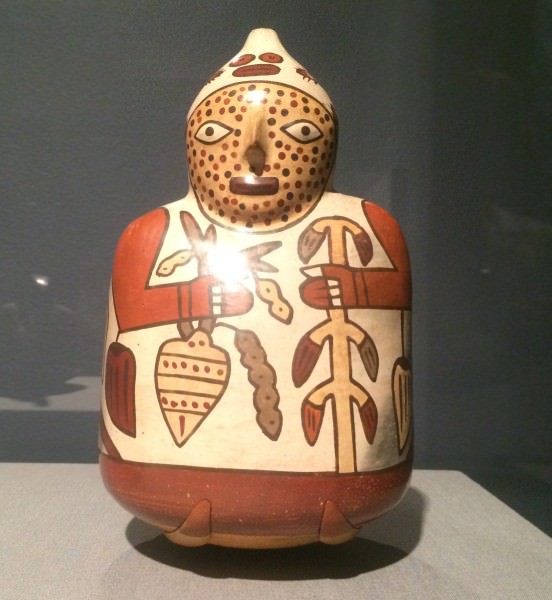
Nazca Figure Vessel
NAZCA POTTERY
The Nazca have achieved a reputation for great artistry and their finely worked pottery is an excellent example. Vessels were thin-walled and could take on a wide variety of shapes. Distinctive forms include the double-spouted containers with a single handle and generally bulbous vessels without a flat bottom or base. Bowls, beakers, jars, effigy drums, and panpipes were also common. There were also vessels in the shape of human heads, no doubt inspired by the Nazca practice of taking trophy-heads following battles.
Influenced by the earlier Paracas culture designs, Nazca pottery vessels were decorated with a slip (before firing) to produce a wide array of vividly rendered patterns, gods, shamanic imagery, crustaceans, condors, monkeys, and mythical transformational creatures, especially felines. The Nazca went on to create their own unique style and designs evolved from naturalistic to highly ornamented and then to highly abstract forms. Often the design covers the entire vessel producing a wrap-around three-dimensional effect, even a narrative, for example, with battle scenes. Designs might also exploit the contours of the vessel, for example, a nose on a protruding part. Designs can also overlap each other to create the illusion of space and depth.
Maroon, light purple, and blue-grey were a favourite choice of colours but a very wide range was used, more, in fact, than in any other ancient Andean culture. Backgrounds were usually in white, red, or black. Outlining figures in black was another feature and another example of the Nazca delight in linear design. A final polishing gave the colours a fine shine.
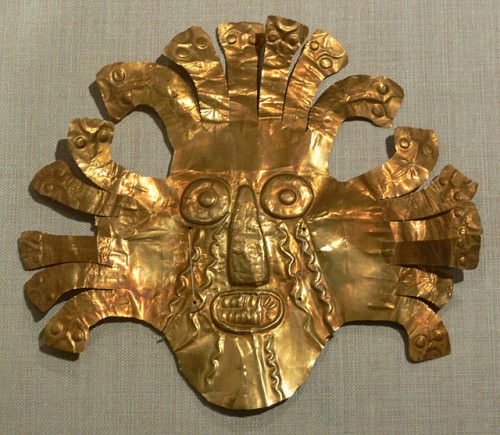
Nazca Gold Mask
NAZCA TEXTILES & METALWORK
The Nazca were fond of not only wool weaving and embroidery but also of painting plain cotton cloth with an array of colourful images and motifs. Textiles have survived remarkably well, thanks to the extremely dry climate, and they illustrate that Nazca weavers possessed the full range of Andean techniques and employed an astonishing range of colours and shades to produce intricate and detailed designs. Figures were especially popular in designs and most often are depicted participating in harvest scenes which show such foodstuffs as maize and beans. Animals, similar to those in the geoglyphs and pottery designs, were also a popular subject. Looms, spindles, needles, cotton balls, and pots of dyes have all been excavated from Nazca settlements.
Nazca metalworkers beat gold into thin sheets which were cut to create silhouettes. Preferring to keep surfaces smooth and reflective, only a little repoussé work provides sparing decoration. Masks were produced which were worn over the mouth and made the wearer appear to have a golden beard and whiskers. Gold full-face masks, hair plumes, and nose and forehead ornaments were also produced. These gold masks transform the face of the wearer and recall the transformation ceremonies carried out by the shamans who were such a popular subject in Nazca art.
Inca Architecture › Antique Origins
Definition and Origins
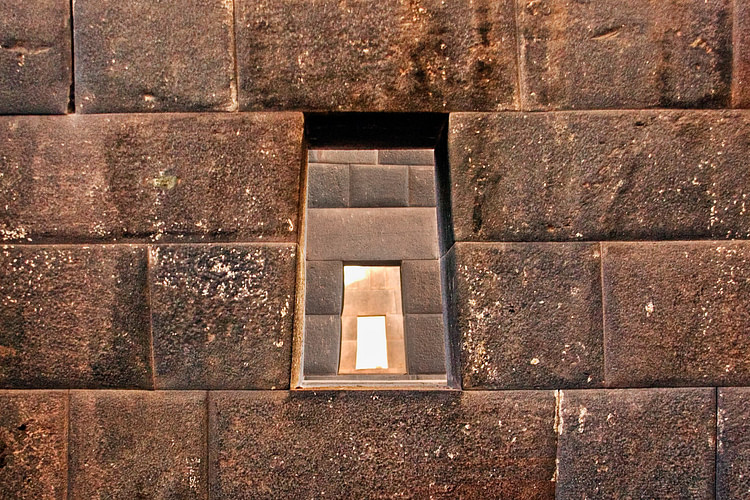
Inca architecture includes some of the most finely worked stone structures from any ancient civilization. Inca buildings were almost always practical and pleasing to the eye. They are also remarkably uniform in design with even grand imperial structures taking on a similar look to more humble buildings, the only significant differences being their much larger scale and quality of finish. Fond of duality in many other areas, another feature of Inca architecture is that it typically incorporated the natural landscape yet at the same time managed to dominate it to create an often spectacular blend of geometrical and natural forms.
MATERIALS
Stone was the material of choice and was finely worked to produce a precise arrangement of interlocking blocks in the finest buildings. The stone was of three types: Yucay limestone, green Sacsayhuaman diorite porphyry, and black andesite. Each block of stone could weigh many tons and they were quarried and shaped using nothing more than harder stones and bronze tools. Marks on the stone blocks indicate that they were mostly pounded into shape rather than cut. Blocks were moved using ropes, logs, poles, levers and ramps (tell-tale marks can still be seen on some blocks) and some stones still have nodes protruding from them or indentations which were used to help workers grip the stone. The fine cutting and setting of the blocks on site was so precise that mortar was not necessary. Finally, a finished surface was often provided using grinding stones and sand.
That rocks were roughly hewn in the quarries and then worked on again at the their final destination is clearly indicated by unfinished examples left at quarries and on various routes to building sites. The meticulous process of laying, removing, re-cutting and then re-laying blocks to make them fit exactly together was slow but experiments have demonstrated that it was much quicker than scholars had previously thought. Even so, it would have taken many months to produce a single wall.Interlocking blocks and sloping walls make Inca buildings extremely resistant, but not immune, to earthquake damage. 500 years of earthquakes have done remarkably little damage to Inca structures left in their complete state.
More humble structures used unworked field stones set with mud mortar or used bricks of dried mud (adobe) in areas with a drier climate. Both types of structure were typically covered in a layer of mud or clay plaster and then painted in bright colours.Walls at Puka Tampu, for example, still have traces of red, black, yellow and white paint.
Roofs were generally made of thatch from grasses or reeds placed on poles made of wood or cane. The poles were tied together using rope and fixed to the stone walls using stone pegs which protruded from them. These pegs could be fitted into the wall or be carved from one of the blocks, they could be circular or square, and they sometimes appear on interior walls to function as pegs, perhaps for textile wall coverings. Sometimes the top of the gable had a stone ring, again for attaching the roof. The incline of roofs was steeper in rainier parts of the empire, often 60 degrees.
TYPICAL FEATURES ARE FINE-CUT STONEWORK, TRAPEZOID SHAPES, AND PURPOSELY POSITIONED PORTALS.
FEATURES
The vast majority of Inca buildings were rectangular and most of these had a single entrance and were composed of only one room as dividing walls are not common in Inca design. There are some rare examples of multiple-doored long rectangular structures and even buildings which were circular or U-shaped but the norm was for straight-walled structures. Most buildings had only a single storey but there are some structures with two, especially those built into hillsides and the more impressive imperial structures at the capital Cuzco where sometimes there are examples of three-storey buildings.
Inca exterior walls commonly slope inwards as they rise (typically around 5 degrees), giving the building a distinctive trapezoid form. The trapeziod form is more common in the north and centre of the empire and one of its optical effects is to make walls seem higher and thicker than they actually are. The trapezoid motif was repeated in doorways, windows and interior wall niches. Doorways and windows often also have double jambs and the former are usually topped with a large single stone lintel.
Architecture in the capital and the imperial buildings dotted across the empire were remarkably similar in their design to other more mundane structures. They were, of course, often much larger in scale and the quality of their stonework was much higher. They could also be more ambitious in design by employing curved walls and they could be decorated more lavishly, for example, with gold sheeting as at the sacred Coricancha precinct at Cuzco whose curved wall section survives in part today.This duality of lower and higher class buildings being the same yet different was very much a trait of the Inca culture in general.
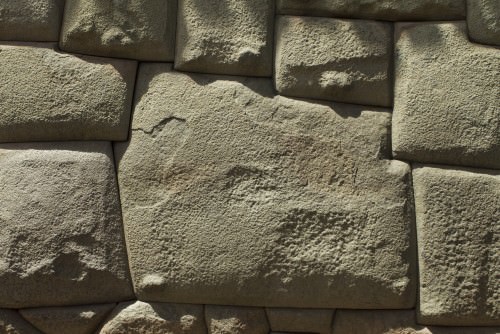
Inca 12 Angle Stone
Inca buildings may have been uniform in their basic design principles and may appear to lack individuality but the names of several architects have survived in the historical record - names like Huallpa Rimichi Inca, Inca Maricanchi, Acahuana, Sinchi Roca, and Calla Cunchuy - which suggests there was some individuality permissible in architectural design.
STRUCTURES
Rectangular buildings could be grouped in threes (or more) and arranged around an open but walled courtyard or patio, perhaps the most common Inca arrangement of buildings. This mini-complex is known as a kancha and functioned as administrative buildings, workshops, temples, accommodation or a mix of these. Very large buildings are known as a kallankaand these typically have several doors and face a large open space, often (once again) trapezoid in layout. They were probably used for public gatherings and as accommodation for representatives of the Inca administration and were clear public symbols of imperial control. Palaces were similar in design to smaller buildings just on a larger scale, with finer stonework and very often walled to restrict access and the viewing of royal personages.
Collca (or Qollqa ) were storehouses which were often built in groups or blocks. They could be round or rectangular but only had a single room. They are often situated on hillsides which gave them both good ventilation and shade, therefore, better preserving their perishable contents. Gravel under-flooring and drainage canals were additional aids in keeping the interior atmosphere dry and allowed for the storage of goods such as grain and potatoes for two years or more.
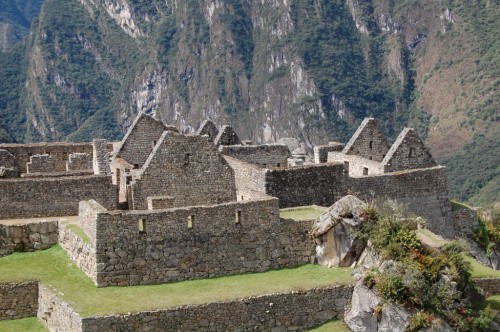
Kallanka, Machu Picchu
Inca settlements were rarely fortified as warfare was generally conducted via set-piece battles and the compliance of conquered peoples was ensured through political, economic and cultural means rather than military ones and imposing imperial architecture was an important part of the colonial process. However, there are exceptions. Some have seen Machu Picchu as a fortified site whilst last-stand settlements against the Spanish such as Ollantaytambo were fortified with large block terrace walls.
Hillside terracing, like buildings, used either loose rocks fixed with mud mortar or finely cut large blocks. They could extend the land available for cultivation and provide better water and drainage for crops but they were also sometimes merely decorative and planted with flowers. Those terraces at Pisac and Ollantaytambo are amongst the most impressive and their design has a definite and planned aesthetic effect.
Even rock outcrops were carved into functional forms by the Inca. For example, at Sacsayhuaman a throne-like carving with steps was cut into a stone hill. Sections of smaller rock outcrops could be cut into geometrical shapes or designs such as zig-zags and rectangles cut into the rock, their exact purpose unknown. Such works also purposely exploited the play of light and shadow to give a further geometrical dimension to the natural landscape. For example, the zig-zag walls at Sacsayhuaman create triangular shadows which seem to mirror the shadows created by the mountain peaks in the background. Rooms were also cut out of natural clefts in rock, one of the most famous being the temple shrine of the sun god Inti beneath the Torreón tower at Machu Picchu.

Machu Picchu
SETTING
Town planning was an important point of consideration for Inca architects. Main roads often cut through towns at an angle, Huánuco Pampa is a good example. Entire zones of a town were built in alignment with the central plaza and its ushnu and royal residences typically faced the sunrise. More generally, the long sides of Inca buildings were usually set parallel to plazas.Blocks of buildings were never quite square and were intersected by narrow straight roads built only for pedestrians.Sometimes even the entire town had a planned form of its own, the most famous example was the intention that the layout of Cuzco should create the figure of a puma when seen from above.
Another important consideration for Inca architects was the placing of buildings, doors and windows in such a way that views were seen to their best advantage and that astronomical bodies and events - certain stars or the sun during the solstices, for example - were visible through these portals. It is rare for the portals of an Inca building not to consider the environment in which they were constructed.
On another level, Inca architects also very often sought to harmoniously blend their structures into the surrounding landscape.Perhaps the most famous example of this is Machu Picchu, which follows the contours of the hillside and even incorporates natural features such as large rocks into the actual buildings. Sometimes the outline of a sacred stone or building was even designed to mimic the contours of a natural feature such as a distant mountain. Other celebrated examples of walls seamlessly incorporating underlying rocks are the hunting lodge of Tambo Machay and the sacred fortress site of Sacsayhuaman at Cuzco. The result of this integration is a somehow harmonious blend of the organic and the geometric and a clear message was given that just as rulers can dominate a subject people, so too humanity can respect, but ultimately dominate, nature.
LICENSE:
Article based on information obtained from these sources:with permission from the Website Ancient History Encyclopedia
Content is available under License Creative Commons: Attribution-NonCommercial-ShareAlike 3.0 Unported. CC-BY-NC-SA License